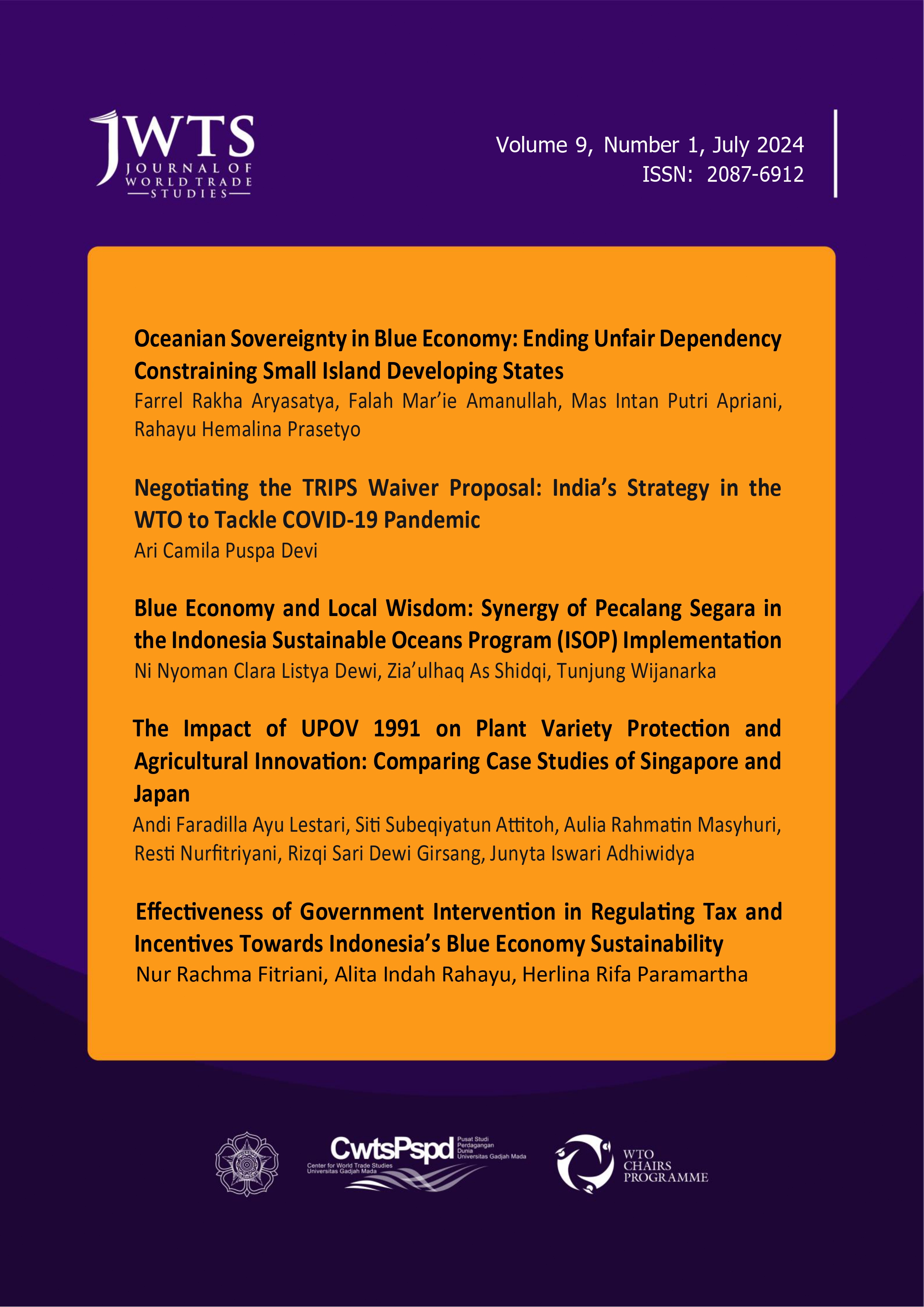Abstract
Indonesia is now focusing on developing more inclusive and sustainable economic growth in the maritime sector. The potential of Indonesia’s marine resources has become the focus of transformation in terms of implementing the blue economy framework. The tourism and maritime sectors are among the largest contributors to the Indonesian economy. However, the analysis and application of the blue economy to the socio-economy of coastal communities have still not received much attention. Previous research on this topic is still limited, particularly regarding the impact of related policies and regulations. Therefore, this paper aims to evaluate the effectiveness of government intervention in imposed tax and incentive provisions as leading factors for implementing a sustainable blue economy. This paper also aims to analyze further the potential and challenges in developing Indonesia’s marine economy. This paper will use the methodology of secondary data analysis and case studies with the approach of public economics. The findings of this paper are recommendations for policy reform to support the blue economy transition in Indonesia, such as mobilizing incentives, developing better resource management systems, and strengthening institutional capacity.
References
Aacl, & Bioflux. (2019). The Economic Impact of Capture Fisheries Development in Indonesia. 12(5). http://www.bioflux.com.ro/docs/2019.1698-1709.pdf
Anna, Z., Hindayani, P., Suryana, A. A. H., Ihsan, Y. N., & Salsabila, A. (2020). Sustainability Study of the Scalloped Hammerhead Shark (Sphyrna Lewini) in Indramayu Waters. Sustainability, 12(24), 10459.
Bappenas. (2021). Blue Economy Development Framework for Indonesia’s Economic Transformation. Jakarta: Ministry of National Development Planning/National Development Planning Agency.
Bari, A. (2017). Our Oceans and the Blue Economy: Opportunities and Challenges. Procedia Engineering, 194, 5-11. https://doi.org/10.1016/j.proeng.2017.08.109
Bennett, N. J., Cisneros-Montemayor, A. M., Blythe, J., Silver, J. J., Singh, G., Andrews, N., ... & Sumaila, U. R. (2019). Towards a Sustainable and Equitable Blue Economy. Nature Sustainability, 211), 991-993. https://doi.org/10.1038/s41893-019-0404-1
Bryan, T., Neumann, C., & Patterson, T. (2015). Blue Economy: Sharing Success Stories to Inspire Change.
Boyle, M. (2022). Tragedy of the Commons. Investopedia. https://www.investopedia.com/terms/t/tragedy-of-the-commons.asp
Cronin, M. A., & George, E. (2023). The Why and How of the Integrative Review. Organizational Research Methods, 26(1), 168-192. https://doi.org/10.1177/1094428120935507
Del Valle Erquiaga, M. I., Astorkitza Ikazuriaga, K. A., & Astorquiza Icazuriaga, M. I. (2012). Tax-Based Fisheries Management: The Case Study of the Cantabrian Anchovy Fishery.
Food and Agriculture Organization of the United Nations (n.d.). Fisheries Bioeconomics: Theory, Modelling, and Management. https://www.fao.org/3/W6914E/W6914E01.htm
Food and Agriculture Organization of the United Nations (2022). The State of World Fisheries and Aquaculture 2022: Fishing Fleet. https://www.fao.org/3/cc0461en/online/sofia/2022/fishing-fleet.html#ref-note-b5_1
Gallo, M., & Thinyane, H. (2021). Supporting Decent Work and the Transition Towards Formalization Through Technology-Enhanced Labor Inspection (No. 41). ILO Working Paper.
Gokkon, B., & Butler, R. A. (2023). A Rule Change Sees Foreign Investors Back in Indonesia’s Fisheries Scene. Mongabay. https://news.mongabay.com/2023/03/indonesia-fisheries-management-policy-foreign-investment-marine-sustainable/
Grahadyarini, B. L. (2022). Minim, Investasi di Sektor Perikanan. Kompas.id. https://www.kompas.id/baca/ekonomi/2022/07/26/investasi-perikanan-minim
Guggisberg, S., & Guggisberg, S. (2016). Chapter 2 Fishing Crisis and Aquaculture. The Use of CITES for Commercially-Exploited Fish Species: A Solution to Overexploitation and Illegal, Unreported, and Unregulated Fishing?, 9-27.
Hardin, G. (2013). The Tragedy of the Commons. In Environmental Ethics (pp. 185-196). Routledge.
Kementerian Kelautan dan Perikanan Republik Indonesia. (2018). Satu Data. kkp.go.id. https://kkp.go.id/setjen/satudata
Kementerian Lingkungan Hidup Republik Indonesia. (2017). Kenali Cantrang, Alat Tangkap Ikan yang Dilarang. menlhk.go.id. https://ppid.menlhk.go.id/berita/berita-pemerintah/2657/kenali-cantrang-alat-tangkap-ikan-yang-dilarang
Kenton, W. (2022). Externality: What It Means in Economics, with Positive and Negative Examples. Investopedia. https://www.investopedia.com/terms/e/externality.asp
Pauli, G. A. (2010). The Blue Economy: 10 Years, 100 Innovations, 100 Million Jobs. Paradigm publications.
Permen KKP No. 35 Tahun 2022. (n.d.). Peraturan BPK. bpk.go.id. https://peraturan.bpk.go.id/Details/265209/permen-kkp-no-35-tahun-2022
Portal PPID BPS Kota Jakarta Utara. (2020). Profil BPS. bps.go.id. https://ppid.bps.go.id/app/konten/3175/Profil-BPS.html
PP No. 78 Tahun 2019. (n.d.). Peraturan BPK. bpk.go.id. https://peraturan.bpk.go.id/Details/126141/pp-no-78-tahun-2019
Pramisti N. Q., & Gumiwang, R. (2018). Sampai Kapan Polemik Larangan Cantrang?. Tirto.id. https://tirto.id/sampai-kapan-polemik-larangan-cantrang-cCwq
Rahayu S.K., et al. (2003). Penerapan Minimal Upah di Jabotabek dan Bandung. SMERU, Jakarta. http://www.smeru.or.id/sites/default/files/publication/umrjabotabekbdg.pdf
Rochwulaningsih, Y., et al. (2019). Marine Policy Basis of Indonesia as a Maritime State: The Importance of an Integrated Economy. Marine Policy, 108, 103602.
Rousseau, Y., et al. (2019). Evolution of Global Marine Fishing Fleets and the Response of Fished Resources. Proceedings of the National Academy of Sciences, 201820344. doi:10.1073/pnas.1820344116
Ryan, R. W., Holland, D. S., & Herrera, G. E. (2014). Ecosystem Externalities in Fisheries. Marine Resource Economics, 29(1), 39-53.
Sakai, Y. (2017). Subsidies, Fisheries management, and Stock Depletion. Land Economics, 93(1), 165-178.
Schuhbauer, A., et al. (2020). The Global Fisheries Subsidies Divide Between Small and Large-Scale Fisheries. Frontiers in Marine Science, 7, 792.
Sulistijowati, R., Yuliati, L., & Komariyah, S. (2023). Analysis of Investment and International Trade on the Gross Domestic Product of the Fisheries Sector in Indonesia: Evidence From the Panel Vector Autoregressive (P-VAR) Model. In IOP Conference Series: Earth and Environmental Science (Vol. 1207, No. 1, p. 012014). IOP Publishing. https://doi.org/10.1088/1755-1315/1207/1/012014
UNEP. (2015). Blue Economy: Sharing Success Stories to Inspire Change. www.unep.org/greeneconomy
Van Anrooy, R., et al. (2021). Review of the Techno-Economic Performance of the Main Global Fishing Fleets. FAO Fisheries and Aquaculture Technical Paper No. 654. Rome, FAO. https://doi.org/10.4060/cb4900en

This work is licensed under a Creative Commons Attribution-NonCommercial-ShareAlike 4.0 International License.

